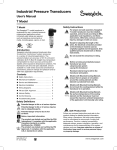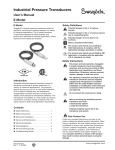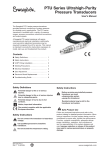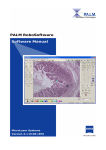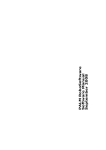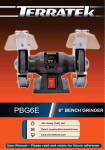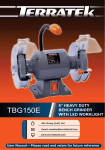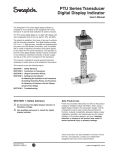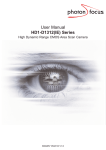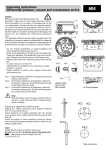Download Industrial Pressure Transducers User`s Manual S Model
Transcript
Industrial Pressure Transducers User’s Manual S Model S Model The Swagelok® S model transducer is ideal for general use in a wide variety of industrial applications such as machine control, process control, laboratory and test equipment, hydraulics, and pneumatics. Safety Instructions Wa r ni ng Wa r ni ng Introduction Swagelok industrial pressure transducers allow for electronic monitoring of system pressures in a variety of industrial applications. The products feature an accuracy of 0.5 % Limit point calibration (0.25 % Best fit straight line), and temperature compensation to ensure accuracy and long term stability when exposed to temperature variations. The transducers are zero and span adjustable, and are available in a wide variety of pressure and electrical connections, pressure ratings, pressure units, and signal outputs to fulfill many application requirements. ■ Safety Instructions . . . . . . . . . . . . . . . . . . . . 1 ■ Mechanical Installation . . . . . . . . . . . . . . . . . 1 ■ Service and Maintenance . . . . . . . . . . . . . . . 2 ■ Electrical Installation . . . . . . . . . . . . . . . . . . 2 ■ Wiring Diagrams . . . . . . . . . . . . . . . . . . . . . . 3 ■ Troubleshooting Guide . . . . . . . . . . . . . . . . . 4 Except for adjusting the length of the wires, the electrical connection provided on the transducer must be used as originally supplied and not bypassed. Only qualified persons should work on these instruments. Do not exceed the overpressure rating. Wa r ni ng Wa r ni ng Before servicing any installed pressure transducer you must ● depressurize system ● purge the transducer Residual material may be left in the transducer and system. Contents ■ Safety Definitions . . . . . . . . . . . . . . . . . . . . . 1 For proper and safe operation, Swagelok S model transducers must be installed, operated, and serviced according to NEC, applicable local regulations, and these instructions. Otherwise, serious personal injuries, damage or both can occur. Wa r ni ng Safe Product Use Follow any enclosed instructions and refer to the product catalog for detailed product information. When using a transducer, the total system design must be considered to ensure safe, trouble-free performance. Function, material compatibility, adequate ratings, proper installation, operation, and maintenance are the responsibilities of the system designer and user. Improper selection or misuse of the product may result in serious personal injury or property damage. Safety Definitions War n i n g Potential danger to life or of serious injuries. War n i n g Potential danger to life or of serious injuries due to catapulting parts. C au t i on Potential danger of burns due to hot surfaces. Mechanical Installation Notice, important information. The product complies with the applicable European directives. The product was tested and certified by CSA International. It complies with the applicable Canadian standards on safety. Certificate-No.: 1567213 MS-CRD-PTI-S Rev 5 12-10-WEL 50 N·m (36 ft·lb) max. www.swagelok.com Electrical Installation Service and Maintenance Zero and Span Adjustment Do not twist or remove housing nut without first removing the fastening screw and electrical connector. Damage to the connector wiring may result if not followed. C au t i on The surfaces of the pressure transducer may get hot during operation. 1. Disconnect the electrical connector by removing the fastening screw. See Fig. A 2. Adjust the zero point (Z) with the transducer in the pressureless state. See Fig. B. 3. Adjust the span (S) while using a pressure standard with adequate accuracy. See Fig. B. 4. Check the output signal to the transducer adjustment. Repeat steps 1 through 3 as necessary. 5. Reassemble transducer as shown in Fig. A. Fig. A Fastening screw Electrical connector Wa r ni ng Do not exceed the max. permissible power supply DC 30 V. The shield / ground connection must be wired to ground to protect the instrument from electromagnetic disturbances. • Attach wiring to the appropriate terminals as shown, (Fig. C) in diagrams on page 3. Wiring information is also printed on the instrument label. • Any DC power supply that meets the voltage requirements of the transducer can be used. Be certain that the voltage supply is higher than the minimum required voltage as determined by the maximum load equations. Maximum Load Equations Milliampere output signal, 2 wire Output 4 to 20 mA Supply V dc = 10 to 30 V Max. Load RL = (V dc – 10) / 0.02 Terminals See drawings Voltage output signal, 3 wire Output 0 to 5 V Supply V dc = 10 to 30 V Min. Load RL > 5 kΩ Terminals See drawings Sealing gasket Fig. B Housing nut Electrical terminals O-ring Voltage output signal, 3 wire Output 0 to 10 V Supply V dc = 14 to 30 V Min. Load RL > 10 kΩ Terminals See drawings Process connector Z = zero point adjustment Fig. C S = span adjustment Do not attempt to clear the pressure port with a screwdriver or other sharp objects as this may damage the sensing element of the transducer. 2 MS-CRD-PTI-S Rev 5 12-10-WEL Wiring Diagrams Legend Power Supply Load (+) V dc+ Plus power (+) supply (–) 0 V dc Minus power (–) supply (common, ground) S+ Plus output signal S– Minus output signal (common, ground) 2-Wire Systems DIN EN 175301-803 L-plug (+) Bendix, 6-pin, MIL plug V dc+/S+ (+) 1 (-) (-) 2 (+) M 12 1, 4 pin Circular connector (-) (+) 0 V dc/S– D B C 0 V dc /S– (+) V dc+/S+ 4 3 1 2 (-) brown (-) grey (shield) green (-) (+) A Direct wire, flying lead (+) V dc+/S+ (-) V dc+/S+ (-) E D C (-) (+) 0 V dc/S– (+) F A B 3 (-) Bendix, 4-pin, MIL plug V dc+/S+ 0 V dc/S– (+) 0 V dc/S– 3-Wire Systems DIN EN 175301-803 L-plug (+) (-) V dc+ V dc+ (+) V dc+ (-) E D C 2 (+) 0 V dc/S– M 12 1, 4 pin Circular connector (+) V dc+ S+ F A B (-) 3 (+) (-) (+) 1 S+ Bendix, 4-pin, MIL plug Bendix, 6-pin, MIL plug (+) (-) 0 V dc/S– (-) A D B C S+ 0 V dc /S– Direct wire, flying lead S+ (+) V dc+ 4 3 (-) S+ 1 2 grey (shield) brown (-) (+) (+) (-) (-) MS-CRD-PTI-S Rev 5 12-10-WEL 0 V dc/S– white green 0 V dc/S– 3 Troubleshooting Guide War n i n g Before servicing any installed pressure transducer, you must ● depressurize the system ● purge the transducer Residual material may be left in the transducer and system. ■ If the transducer becomes damaged or unsafe for operation, remove it from service and mark to prevent it from being used accidentally. War n i n g ■ Have repairs performed by the manufacturer only. Do not insert any pointed or hard objects into the pressure port for cleaning. Problem Possible Causes Remedy Output signal unchanged after change in pressure Mechanical overload through overpressure Replace transducer➀ Mechanical overload through overpressure Re-calibrate transducer Diaphragm is damaged, e.g. through impact Replace transducer➀ Signal span too small / aggressive media; corrosion of Signal span dropping off / Abrasive diaphragm / pressure connector; transmission Replace transducer➀ too small fluid missing. Signal span erratic Signal span incorrect Electromagnetic interference source in the vicinity, e.g. inverter drive Shield the transducer; shield the cables; remove the interference source Working temperature too high / too low Ensure permissible temperatures (see Operating Instructions) Working temperature too high / too low Ensure permissible temperatures (see Operating Instructions) Medium or ambient temperature too high / too low Control the internal temperature of the transducer within the permissible range; observe the allowable temperture error (see Operating Instructions) Abnormal zero point signal Abnormal mounting position No output signal Correct the zero point through the potentiometer Overload limits exceeded Ensure permissible overload limits are observed (see Operating Instructions); correct the zero point through the potentiometer Cable break Check connections and cable ➀ Adjusting the controller or display device can usually compensate for small changes in the output signal. Test the system for proper operation after adjustments are made. An excessive change in the output signal indicates possible transducer damage. This may cause the output to be non-linear, requiring transducer replacement. Storage and Disposal Purge all media from the pressure transducer before storage or disposal of the transducer. War n i n g Mount the protection cap when storing a flush diaphragm pressure transducer to prevent damage. Dispose of transducer components and packaging materials in accordance with the respective waste treatment and disposal regulations of the region or country to which the transducer is supplied. Do not mix or interchange parts with those of other manufacturers. Swagelok Company 29500 Solon Road Solon Ohio 44139 U. S. A. For product technical data, including materials of construction, see the Swagelok Industrial Pressure Transducers catalog, MS-02-225. Authorized Representative in Europe: Translations are available on www.swagelok.com Swagelok A.G.—Manufacturing Tech Center / Distribution Center P.O. Box 552 CH-8853 Lachen, Switzerland Swagelok—TM Swagelok Company © 2004 — 2010 Swagelok Company MS-CRD-PTI-S, R5 December 2010




